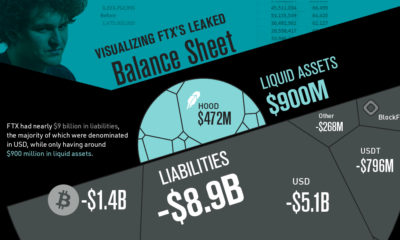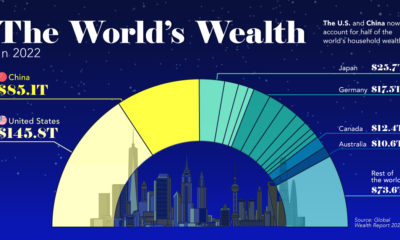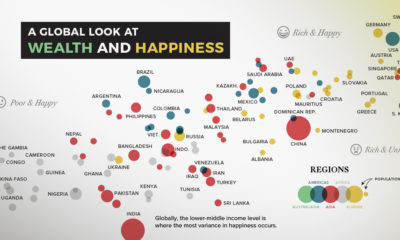However, as with any newly emerging field, being in the spotlight can present a double-edged sword. It makes for an environment full of passionate and extremely technical discussion, but it also opens the door to blatant promotional pump-and-dump schemes and inflexible factions of cheerleaders or naysayers. This clutter makes it considerably difficult for the average person to really wrap their head around the crypto space – and it creates opportunities to simplify the sector in an easy, digestible, and accessible way.
A Guide to Cryptocurrencies
Today’s infographic from BestAccountingSchools provides an introductory guide to cryptocurrencies, and it highlights the history, important terms, and statistics about the crypto space. It also profiles some of the pioneers that made it all happen. It’s a great start for anyone looking to get up to speed on what’s happening in crypto – and we thought we would accompany it with some additional infographic resources that we have available on the topic as well. Bitcoin’s Journey to $10,000 – This timeline chart catalogs Bitcoin’s wild 2017, in which it catapulted from $1,000 to $10,000 in just 11 months. Comparing Crypto – This giant infographic compares the differences in design and protocol of six key cryptocurrencies: Bitcoin, Ethereum, Litecoin, Ethereum Classic, Dash, and Ripple. The ICO Explosion – The popularity of cryptocurrency has also led to a boom in initial coin offerings (ICOs). This nifty data visualization helps to show this. Top 25 Cryptocurrencies – This infographic showcases the top 25 cryptocurrencies, organized by different factors: market cap, trading volume, purpose, and inception date. Intro to Smart Contracts – Cryptocurrencies aren’t just about payments – they are also being used to automate transactions to avoid middlemen. This infographic on the power of smart contracts helps to introduce these concepts. Historical Context – All the way back in 2013 and 2014, we put together infographics documenting the first 5 years of Bitcoin’s history, as well as why we predicted that Bitcoin would eventually disrupt banking in 2014. Do you have any other great graphical resources that could be included for a beginner’s guide to cryptocurrencies? Let us know in the comments.
on Last year, stock and bond returns tumbled after the Federal Reserve hiked interest rates at the fastest speed in 40 years. It was the first time in decades that both asset classes posted negative annual investment returns in tandem. Over four decades, this has happened 2.4% of the time across any 12-month rolling period. To look at how various stock and bond asset allocations have performed over history—and their broader correlations—the above graphic charts their best, worst, and average returns, using data from Vanguard.
How Has Asset Allocation Impacted Returns?
Based on data between 1926 and 2019, the table below looks at the spectrum of market returns of different asset allocations:
We can see that a portfolio made entirely of stocks returned 10.3% on average, the highest across all asset allocations. Of course, this came with wider return variance, hitting an annual low of -43% and a high of 54%.
A traditional 60/40 portfolio—which has lost its luster in recent years as low interest rates have led to lower bond returns—saw an average historical return of 8.8%. As interest rates have climbed in recent years, this may widen its appeal once again as bond returns may rise.
Meanwhile, a 100% bond portfolio averaged 5.3% in annual returns over the period. Bonds typically serve as a hedge against portfolio losses thanks to their typically negative historical correlation to stocks.
A Closer Look at Historical Correlations
To understand how 2022 was an outlier in terms of asset correlations we can look at the graphic below:
The last time stocks and bonds moved together in a negative direction was in 1969. At the time, inflation was accelerating and the Fed was hiking interest rates to cool rising costs. In fact, historically, when inflation surges, stocks and bonds have often moved in similar directions. Underscoring this divergence is real interest rate volatility. When real interest rates are a driving force in the market, as we have seen in the last year, it hurts both stock and bond returns. This is because higher interest rates can reduce the future cash flows of these investments. Adding another layer is the level of risk appetite among investors. When the economic outlook is uncertain and interest rate volatility is high, investors are more likely to take risk off their portfolios and demand higher returns for taking on higher risk. This can push down equity and bond prices. On the other hand, if the economic outlook is positive, investors may be willing to take on more risk, in turn potentially boosting equity prices.
Current Investment Returns in Context
Today, financial markets are seeing sharp swings as the ripple effects of higher interest rates are sinking in. For investors, historical data provides insight on long-term asset allocation trends. Over the last century, cycles of high interest rates have come and gone. Both equity and bond investment returns have been resilient for investors who stay the course.













